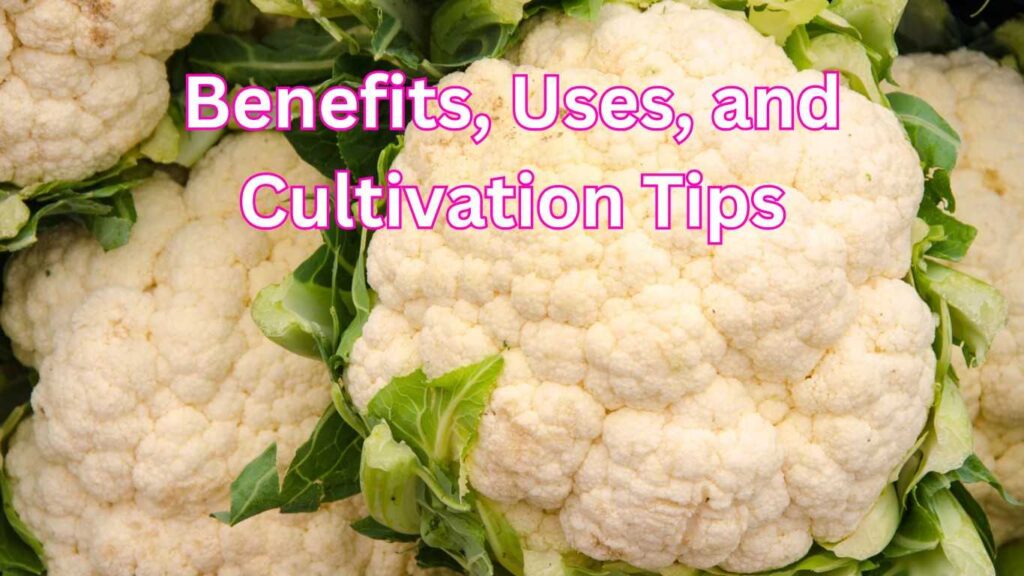Cauliflower/Couve-Flor Benefits, Uses, and Commercial Cultivation Tips
Introduction
Cauliflower, commonly referred to as couve-flor in Brazil, is a nutrient-dense vegetable loved for its versatility in cooking and its health benefits. Whether you are roasting it, turning it into rice, or preparing a creamy gratin, cauliflower is a must-have in kitchens worldwide. This post will explore its health benefits, its significance in global cuisines, and provide easy recipes for you to try.
What is Cauliflower (Couve-Flor)?
Cauliflower, scientifically known as Brassica oleracea, is part of the cruciferous vegetable family, along with broccoli, kale, and cabbage. Known as couve-flor in Brazil, it is a popular choice for healthy meals.
- Appearance: Cauliflower typically has a white, compact head called the “curd,” but purple, green, and orange varieties also exist.
- History: Originally cultivated in the Mediterranean region, cauliflower has become a global favorite.
- Global Names:
- English: Cauliflower
- Portuguese (Brazil): Couve-flor
- Spanish: Coliflor
Health Benefits of Cauliflower (Couve-Flor)
- Rich in Nutrients
- Cauliflower is low in calories but packed with vitamins C, K, and B6, along with folate and fiber.
- It contains antioxidants that fight inflammation and protect against chronic diseases.
- Aids in Digestion
- The high fiber content in cauliflower supports a healthy digestive system and prevents constipation.
- Supports Weight Loss
- Being low in carbs and calories, it is a perfect choice for keto and low-carb diets.
- Promotes Heart Health
- The antioxidants and fiber in cauliflower reduce bad cholesterol levels and improve overall heart health.
- Strengthens Bones
- Rich in vitamin K, cauliflower helps maintain strong bones.
Popular Recipes with Cauliflower (Couve-Flor)
1. Roasted Cauliflower (Cauliflower Assado)
Ingredients:
- 1 medium cauliflower
- Olive oil, salt, pepper, and garlic powder
Steps:
- Preheat the oven to 200°C (400°F).
- Cut the cauliflower into florets and season with olive oil, salt, pepper, and garlic powder.
- Roast for 25–30 minutes until golden brown.
2. Brazilian Couve-Flor Gratinada
Ingredients:
- 1 head of couve-flor
- 2 cups of milk
- 2 tbsp of butter
- 2 tbsp of flour
- 1 cup of grated cheese (e.g., mozzarella or parmesan)
Steps:
- Boil the couve-flor florets for 5–7 minutes.
- Prepare a white sauce by melting butter, adding flour, and slowly whisking in milk.
- Pour the sauce over the couve-flor, top with cheese, and bake at 180°C (350°F) for 20 minutes.
3. Cauliflower Rice
Ingredients:
- 1 medium cauliflower
- 2 tbsp olive oil
- Salt and spices as needed
Steps:
- Grate the cauliflower or pulse it in a food processor to create rice-like granules.
- Sauté in olive oil for 5–7 minutes.
How to Choose and Store Cauliflower (Couve-Flor)
- Choosing: Look for firm, white heads without brown spots.
- Storing: Wrap in a plastic bag and refrigerate. It stays fresh for up to a week.
- Freezing: Blanch the florets before freezing to maintain their texture and flavor.
Why Include Cauliflower (Couve-Flor) in Your Diet?
Cauliflower and couve-flor are versatile ingredients that fit into various diets, including keto, vegan, and gluten-free lifestyles. From soups to salads, they can transform simple meals into gourmet dishes.
Here’s the additional information in English that you can add to the bottom of your post:
Additional Information: Benefits and Commercial Aspects of Cauliflower
Cauliflower for Skincare
The antioxidants and vitamin C in cauliflower help improve skin health, boost brightness, and reduce wrinkles. Applying a cauliflower-based paste can act as a natural moisturizer.
Role in Cancer Prevention
Compounds like sulforaphane in cauliflower are particularly effective in reducing the risk of colon, breast, and prostate cancer.
Commercial Cultivation of Cauliflower
Cauliflower, or couve-flor, is cultivated to meet both local and international market demands. It thrives in fertile, well-drained soil with cool weather conditions.
FAQ: Common Questions About Cauliflower
1. Which Parts of Cauliflower Are Edible?
The white florets are the primary edible parts, but the stems and leaves can be used in soups or broths.
2. Is Cauliflower Gluten-Free?
Yes, cauliflower is entirely gluten-free, making it a safe choice for various diets.
3. Why Does Cauliflower Taste Bitter Sometimes?
Overcooking or improper storage can cause cauliflower to develop a bitter taste.
Conclusion
Cauliflower, or couve-flor, is more than just a vegetable—it’s a global culinary favorite with immense health benefits. Whether you’re in the USA or Brazil, incorporating cauliflower into your meals can add nutrition, flavor, and creativity to your diet. Try out the recipes shared above, and enjoy the versatility of this amazing vegetable!











